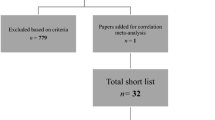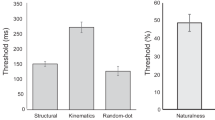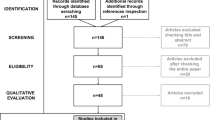Abstract
Biological motion is easily perceived by neurotypical observers when encoded in point-light displays. Some but not all relevant research shows significant deficits in biological motion perception among those with ASD, especially with respect to emotional displays. We tested adults with and without ASD on the perception of masked biological motion and the perception of direction from coherent and scrambled biological motion. Within the autism spectrum group, there was a large and statistically significant relationship between IQ and the ability to perceive directionality in masked biological motion. There were no group differences in sensitivity to biological motion or the ability to identify the direction of motion. Possible explanations are discussed, including the possible use of compensatory strategies in high IQ ASD.

Similar content being viewed by others
References
Abell, F., Happe, F., & Frith, U. (2000). Do triangles play tricks? Attribution of mental states to animated shapes in normal and abnormal development. Journal of Cognitive Development, 15, 1–20.
Atkinson, A. P. (2009). Impaired recognition of emotions from body movements is associated with elevated motion coherence thresholds in autism spectrum disorders. Neuropsychologia, 47, 3023–3029.
Barclay, C. D., Cutting, J. E., & Kozlowski, L. T. (1978). Temporal and spatial factors in gait perception that influence gender recognition. Perception and Psychophysics, 23, 145–152.
Beardsworth, T., & Buckner, T. (1981). The ability to recognize oneself from a video recording of one’s movements without seeing one’s body. Bulletin of the Psychonomic Society, 18, 19–22.
Blake, R., Turner, L. M., Smoski, M. J., Pozdol, S. L., & Stone, W. L. (2003). Visual recognition of biological motion is impaired in children with autism. Psychological Science, 14, 151–157.
Bowler, D. M., & Thommen, E. (2000). Attribution of mechanical and social causality to animated displays by children with autism. Autism, 4, 147–171.
Brainard, D. H. (1997). The Psychophysics Toolbox. Spatial Vision, 10, 433–436.
Castelli, F., Frith, C., Happe, F., & Frith, U. (2002). Autism, asperger syndrome and brain mechanisms for the attribution of mental states to animated shapes. Brain, 125, 1839–1849.
Celani, G., Battacchi, M. W., & Arcidiacono, L. (1999). The understanding of the emotional meaning of facial expressions in people with autism. Journal of Autism and Developmental Disorders, 29, 57–66.
Chang, D. H. F., & Troje, N. F. (2009). Characterizing global and local mechanisms in biological motion perception. Journal of Vision, 9, 1–10.
Congiu, S., Schlottmann, A., & Ray, E. (2010). Unimpaired perception of social and physical causality, but impaired perception of animacy in high functioning children with autism. Journal of Autism and Developmental Disorders, 40, 39–53.
Cutting, J. E., & Kozlowski, J. T. (1977). Recognizing friends by their walk: Gait perception without familiarity cues. Bulletin of the Psychonomic Society, 9, 353–356.
Dakin, S., & Frith, U. (2005). Vagaries of Visual Perception in Autism. Neuron, 48, 497–507.
Freitag, C. M., Konrad, C., Haberlen, M., Kleser, C., von Gontard, A., Reith, W., et al. (2008). Perception of biological motion in autism spectrum disorders. Neuropsychologia, 46, 1480–1494.
Happé, F., & Frith, U. (2006). The weak central coherence account: Detail-focussed cognitive style in autism spectrum disorders. Journal of Autism and Developmental Disorders, 36, 5–25.
Hubert, B., Wicker, B., Moore, D. G., Monfardini, E., Duverger, H., Da Fonseca, D., et al. (2006). Brief report: Recognition of emotional and non-emotional biological motion in individuals with autistic spectrum disorders. Journal of Autism and Developmental Disorders, 37, 1386–1392.
Johansson, G. (1973). Visual perception of biological motion and a model for its analysis. Perception and Psychophysics, 14, 201–211.
Jokisch, D., Daum, I., & Troje, N. F. (2006). Self recognition versus recognition of others by biological motion: Viewpoint-dependent effects. Perception, 35, 911–920.
Klin, A. (2000). Attributing social meaning to ambiguous visual stimuli in higher-functioning autism and asperger syndrome: The social attribution task. Journal of Child Psychology and Psychiatry and Allied Disciplines, 41, 831–846.
Klin, A., & Jones, W. (2008). Altered face scanning and impaired recognition of biological motion in a 15-month-old infant with autism. Developmental Science, 11, 40–46.
Klin, A., Lin, D. J., Gorrindo, P., Ramsay, G., & Jones, W. (2009). Two-year-olds with autism fail to orient towards human biological motion but attend instead to non-social, physical contingencies. Nature, 459, 257–261.
Koldewyn, K., Whitney, D., & Rivera, S. M. (2010). The psychophysics of visual motion and global form processing in autism. Brain, 133, 599–610.
Lord, C., Risi, S., Lambrecht, L., Cook, E. H., Leventhal, B. L., DiLavore, P. C., et al. (2000). The autism diagnostic observation schedule-generic: A standard measure of social and communication deficits associated with the spectrum of autism. Journal of Autism and Developmental Disorders, 30, 205–223.
Lord, C., Rutter, M., & LeCouteur, A. (1994). Autism diagnostic interview-revised: A revised version of a diagnostic interview for caregivers of individuals with possible pervasive developmental disorders. Journal of Autism and Developmental Disorders, 24, 659–685.
Maestro, S., Muratori, F., Cavallaro, M. C., Pei, F., Stern, D., Golse, B., et al. (2002). Attentional skills during the first 6 months of age in autism spectrum disorder. Journal of the American Academy of Child and Adolescent Psychiatry, 41, 1239–1245.
Mather, G., & Murdoch, L. (1994). Gender discrimination in biological motion displays based on dynamic cues. Proceedings of the Royal Society of London, B, 258, 273–279.
Moore, D. G., Hobson, R. P., & Lee, P. W. (1997). Components of person perception: An investigation with autistic, non-autistic retarded and typically developing children and adolescents. British Journal of Developmental Psychology, 15, 401–423.
Mottron, L., Dawson, M., Soulières, I., Hubert, B., & Burack, J. (2006). Enhanced perceptual functioning in autism: An update, and eight principles of autistic functioning. Journal of Autism and Developmental Disorders, 36, 27–43.
Murphy, P., Brady, N., Fitzgerald, M., & Troje, N. F. (2009). No evidence for impaired perception of biological motion in adults with autistic spectrum disorders. Neurophychologia, 47, 3225–3235.
Parron, C., Da Fonseca, D., Santos, A., Moore, D. G., Monfardini, E., & Deruelle, C. (2008). Recognition of biological motion in children with autistic spectrum disorders. Autism, 12, 261–274.
Pelli, D. G. (1997). The videotoolbox software for visual psychophysics: Transforming numbers into movies. Spatial Vision, 10, 437–442.
Rutherford, M. D., Pennington, B. F., & Rogers, S. J. (2006). The perception of animacy in young children with autism. Journal of Autism and Developmental Disorders, 36, 893–992.
Salter, G., Seigal, A., Claxton, M., Lawrence, K., & Skuse, D. (2008). Can autistic children read the mind of an animated triangle? Autism, 12, 349–371.
Troje, N. F. (2002). Decomposing biological motion: A framework for analysis and synthesis of human gait patterns. Journal of Vision, 2, 371–387.
Troje, N. F. (2008). Biological motion perception. In A. Basbaum (Ed.), The senses: A comprehensive reference (pp. 231–238). Oxford: Elsevier.
Troje, N. F., & Westhoff, C. (2006). The inversion effect in biological motion perception: Evidence for a “life detector”? Current Biology, 16, 821–824.
Wechsler, D. (1997). Wechsler adult intelligence scale (3rd ed.). San Antonio, TX: Psychological Corporation Harcourt Brace and Company.
Author information
Authors and Affiliations
Corresponding author
Rights and permissions
About this article
Cite this article
Rutherford, M.D., Troje, N.F. IQ Predicts Biological Motion Perception in Autism Spectrum Disorders. J Autism Dev Disord 42, 557–565 (2012). https://doi.org/10.1007/s10803-011-1267-0
Published:
Issue Date:
DOI: https://doi.org/10.1007/s10803-011-1267-0




